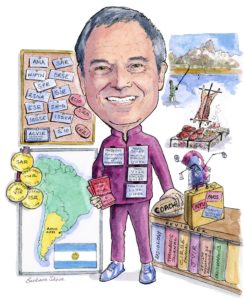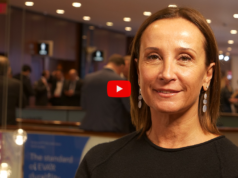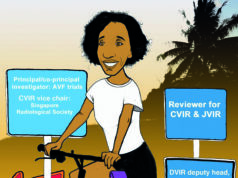 Establishing the first Interventional Radiology department in Argentina, Ricardo García-Mónaco is a pioneer of minimally invasive, image-guided therapies in South America. Looking back on a career that spans more than three decades, he discusses how establishing interventional radiology (IR) as a clinical discipline rather than a technical one is crucial for the field’s survival and success, and recalls a particularly memorable case where IR intervention in a two-day-old baby saved the patient from amputation and enabled her to go on to become the healthy, active teenager she is today.
Establishing the first Interventional Radiology department in Argentina, Ricardo García-Mónaco is a pioneer of minimally invasive, image-guided therapies in South America. Looking back on a career that spans more than three decades, he discusses how establishing interventional radiology (IR) as a clinical discipline rather than a technical one is crucial for the field’s survival and success, and recalls a particularly memorable case where IR intervention in a two-day-old baby saved the patient from amputation and enabled her to go on to become the healthy, active teenager she is today.
What initially attracted you to interventional radiology (IR)?
When I was in my second year of residency in radiology, in 1985, my hospital incorporated digital subtraction angiography equipment, the first of its kind in my country. Before that the Radiology departments in Argentina did not have vascular suites. I was selected by the chair of Radiology to join the new Angiography Unit (at the time the unit only performed diagnostic examinations), in addition to the regular residency curricula. I was very happy with the patient commitment I could get in radiology through this subspecialty, and started reading about the subject in the radiology journals that we had at the time in Argentina: American Journal of Roentgenology (AJR) and Radiology. I was rapidly fascinated by the possibilities of therapeutic angiography, as it was then called. I foresaw the tremendous future of the endovascular approach as a proper tool to treat different diseases, especially through embolization procedures that were not recognised or regularly performed at that time in my country. Except for cardiologists performing angioplasty procedures, there were not many physicians interested in vascular procedures, and I realised it was a great opportunity to develop my career in what was a rather “unknown” area in Argentina at the time.
Who have been important mentors for you throughout your career?
I was very lucky to have important mentors in my career, who positively marked my professional and personal pathways. First of all, during my residency, Eduardo De Santibanes, an outstanding young liver surgeon at the time, introduced me to the importance of clinical commitment and patient follow-up—not very common amongst radiologists. He always encouraged me to be in the operating room while surgery was being conducted on any of my angiography patients, and then to go to the pathology department to observe the specimen resected. He was very keen to explain every detail of the surgery to me, and to elucidate the correlation with the imaging studies I had performed preoperatively. Years later, when I went to France to train in vascular and interventional radiology, I was lucky enough to meet two outstanding mentors: Pierre Lasjaunias and Alain Roche. Knowing them and incorporating their ways of practicing IR was a breakthrough in my career. They were top IR physicians ahead of their time, and they developed the foundations of many of the clinical and technical interventions still performed to this day worldwide. Indeed, both of them were mentors for a whole generation of interventional radiologists, and many that trained with them are now successful professionals at different international facilities.
Which innovations have most influenced your career, and how?
As I have been in IR for 30 years, I have seen many innovations, including technical developments, material refinements, new devices, new interventions, new indications of IR treatments, and improvements in equipment and software. But what has most influenced my career has been the conceptual shift from IR being a technical speciality to becoming a clinical, patient-centred one. Indeed, this “innovation” is increasing IR recognition among other clinical and surgical specialties, allowing interdisciplinary interactions to offer IR as a solution to the patient as it occurs with medical or surgical therapies. A nice example of innovation in this setting is the recent development of interventional oncology, now regarded as the forth pillar of cancer care, joining medical, surgical, and radiation oncology.
What were the biggest challenges and rewards in establishing Argentina’s first interventional radiology department?
Argentina being a rather conservative country, one of the biggest challenges was overcoming the disbelief that a radiologist could have a therapeutic role and run an interventional department. As radiologists are commonly regarded as physicians who only work with images and who do not interact with patients, both patients and doctors were unaware of the possibilities of IR. I remember in my early days back from France, every indication and every procedure I performed were like tests, because my results were under constant scrutiny from other physicians. Demonstrating that IR training differs a lot from that of diagnostic radiology and that we are specifically trained to treat certain diseases, along with our positive results, minimised this reluctance. Another big challenge was to organise all the staff, including nurses and technicians, as the path to success is dependent on paramedical staff as well as IR. Doing so many procedures requiring specific materials for the very first time in my country (such as transarterial chemoembolization (TACE), radiofrequency ablation (RFA), transjugular intrahepatic portosystemic shunt (TIPS), and venous stenting), I had to explain the advantages of IR to the hospital administrators and payers, as these were initially regarded just as additional costs. Indeed, this challenge still continues today with procedures recently introduced to my country, such as radioembolization, cryoablation, and venous deprivation. On the other hand, establishing an Endovascular Therapy and Interventional Radiology department was very rewarding. Developing a single department performing all types of image-guided therapies regardless of the organ (except for the heart) prevented other specialties from developing these types of procedures in their own domain. This was different to other hospitals, where neurointerventions, peripheral angioplasty, aortic aneurysm grafts, vertebroplasty, and many other procedures were being performed by other specialities. A single, broad department allowed not only important clinical activity, but also enabled educational endeavours, evidenced by the number of young Latin American interventional radiologists trained at our facility. Being recognised as one of the best teaching centres in Latin America and the high quality standards advocated by the Joint Commission is one of the biggest rewards for me.
As a founding member of the Argentine College of Vascular and Interventional Radiology (CARVI), what are your ambitions for the society?
I was the first president of this recently created society. The main goals are to foster education in IR and to work with the national government to recognise IR as a true speciality. Additionally, it is a facilitator for physicians interested in the subject and wanting to pursue an IR career. It is also a professional and juridical way to interact with other medical specialities and the minister of health from an official position.
What is the most exciting research coming from South America in IR right now, in your opinion?
The expenditure on research in South America is very low compared to other regions. However, some exciting research has originated from South America, such as the introduction of stent grafts to treat aortic aneurysms (albeit developed by a vascular surgeon), or the first prostate arterial embolization (together with Portugal). The latter, developed by Francisco Carnevale in Brazil, is probably the most relevant research to come out of South America in recent years. The same group is still performing additional work on the matter, and we have studied the macro- and microvascular anatomy of the prostate and its implications for embolization. The field of interventional oncology is very exciting, and we are part of some international randomised controlled trials, including RETNET, the first study to compare bland embolization versus conventional TACE versus DEBTACE in neuroendocrine liver tumours.
Would you describe a particularly memorable case?
I have many memorable cases—some due to amazing, positive results, and others that have saved patients’ lives or much improved their quality of life. Among these, maybe the most memorable was a newborn with a life-threatening condition due to multi-organ haemorrhages and congestive heart failure, secondary to a giant right lower limb tumour (Kaposiform Hemangioendothelioma). The patient was so critically ill, despite medication, that amputation of her right leg was considered to stop the irreversible coagulopathy caused by the tumour. Instead, we intervened to embolize the tumour early on the second day of life—a challenging intervention in this 3kg, decompensated newborn—which lead to a dramatic and total recovery. Most memorably, I met the patient recently, now a teenager with a normal life, practicing several sports, including volleyball and dancing. This made me very happy, especially considering she risked amputation as a newborn, and this was not done thanks to our IR decision.
What do you think the future of IR will look like?
IR has a bright future, because innovations and improvements in imaging capabilities are constant. However, IR needs to become a true clinical specialty, just like surgery or paediatrics. IR has not yet found the correct pathway to succeed and survive. Should it be a subspecialty of radiology, or should it run separate and by itself? Should the medical community or payers accept IR as a self-specialty, or as a therapeutic technique inside a broad specialty (as is the case with “interventional neurosurgery”, performed by neurosurgeons, and “endovascular surgery”, performed by vascular surgeons)? Of course I do not have the answer, but new generations of interventional radiologists should consider that clinical competence is as important as technical skill. IR procedures will continue to grow, because in my view the number of open surgeries being performed will continue to fall, and ultimately these will be replaced by minimally invasive or medical options, except for in a few indications.
What is the biggest challenge in IR today?
Atomisation of the specialty by other disciplines could jeopardise the future of IR. The most notorious examples are neurointerventional procedures that in many countries are performed by neurosurgeons, or endovascular interventions performed by vascular surgeons. Interestingly, in some countries there is a trend for surgical departments to establish a “percutaneous surgery unit” that performs drainage of fluid collections, gastrostomy, bile duct interventions, and even tumour ablations. I think this is one of the biggest challenges in IR at the moment; strategies must be built accordingly. Fortunately, SIR, CIRSE, and many other IR societies are aware of this and are currently facing this problem.

What are your hobbies and interests outside of medicine?
I am a family man, so enjoy spending time with my family, watching soccer games with my son or daughter in stadiums, and seeing my son play in the Argentinian Rugby Union tournament. I love sports, and played rugby in the first division during my youth. More recently, I have been coaching young rugby teams for several years. I used to ski with the family every winter and like to fly cast in Patagonia lakes and rivers in the summer. I also like to cook a typical Argentine meal called “asado” on Sundays, a kind of firewood grilled beef, and to watch movies or TV series at night, or dine with friends and family.
Fact file
Current positions
- 1992–Present: Head of Interventional Radiology and Endovascular Therapy, Hospital Italiano, University of Buenos Aires, Buenos Aires, Argentina
- 2005–Present: Head of Vascular and Interventional Radiology, Hospital Italiano, University of Buenos Aires, Buenos Aires, Argentina
Previous positions
- 2005–2018: Chair of Department of Radiology, Hospital Italiano, University of Buenos Aires, Buenos Aires, Argentina
- 1991–1992: Medecin Consultant, Radiologe Interventionelle, IGR, Villejuif, France
- 1991: Medecin Assistant a Titre Etranger, Bicêtre Hospital, University of Paris, Paris, France
- 1990: Visiting Fellowship, Toronto Western Hospital, Toronto, Canada
- 1990: Visiting Fellowship, New York University, New York, USA
- 1988–1992: Training in Angiography and Interventional Radiology, Bicêtre Hospital, University of Paris
- 1987–1988: Senior Chief Resident, Hospital Italiano, University of Buenos Aires, Buenos Aires, Argentina
- 1983–1987: Residency in Radiology, Hospital Italiano, University of Buenos Aires, Buenos Aires, Argentina
Society positions
- 2016–2018: President of the International Society of Radiology (ISR)
- 2014–2018: President and founding member of the Argentine College of Vascular and Interventional Radiology
- 2006–2008: President of Inter-American College of Radiology (CIR)
- 2000–2006: President of the Argentine Society of Radiology (SAR)










